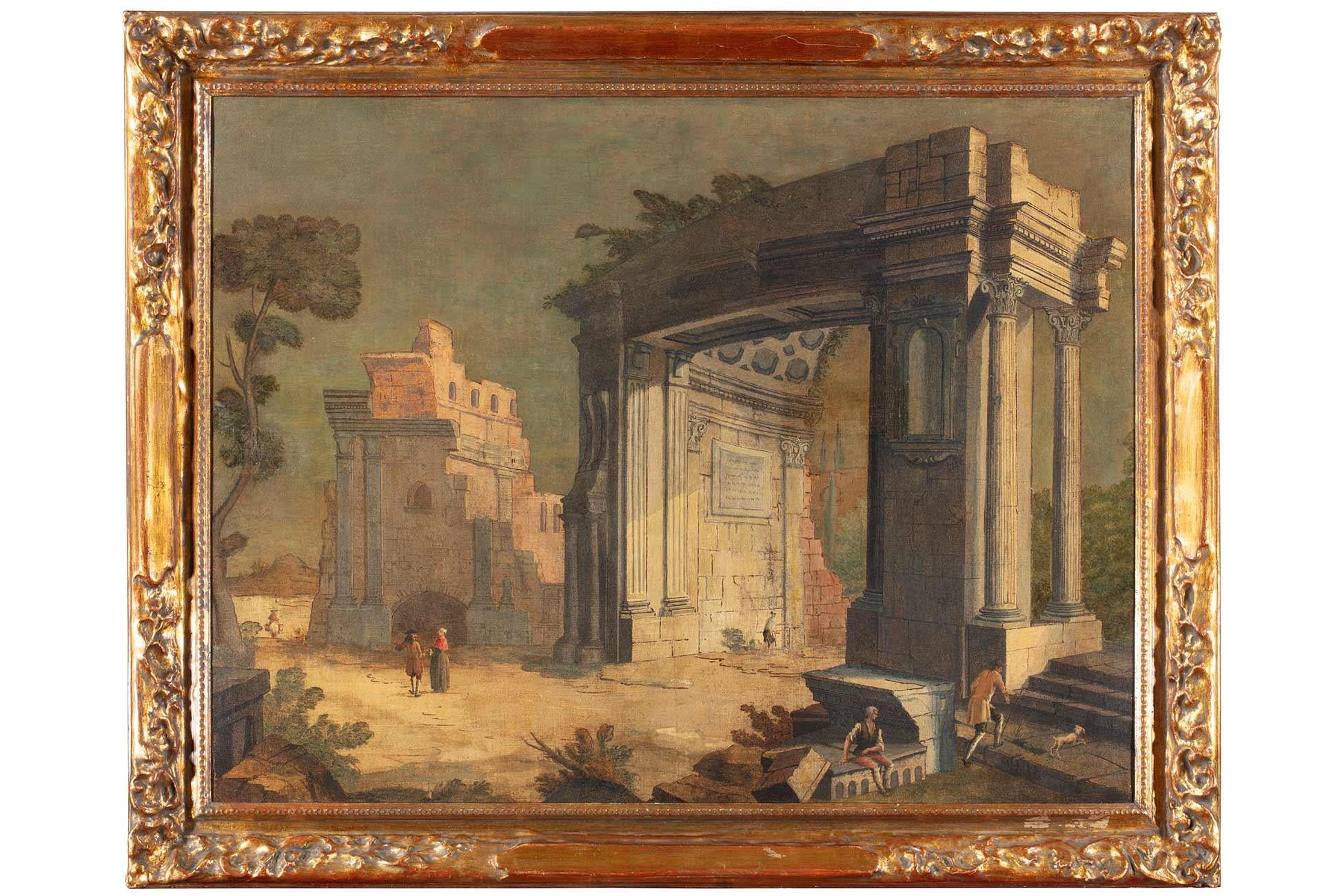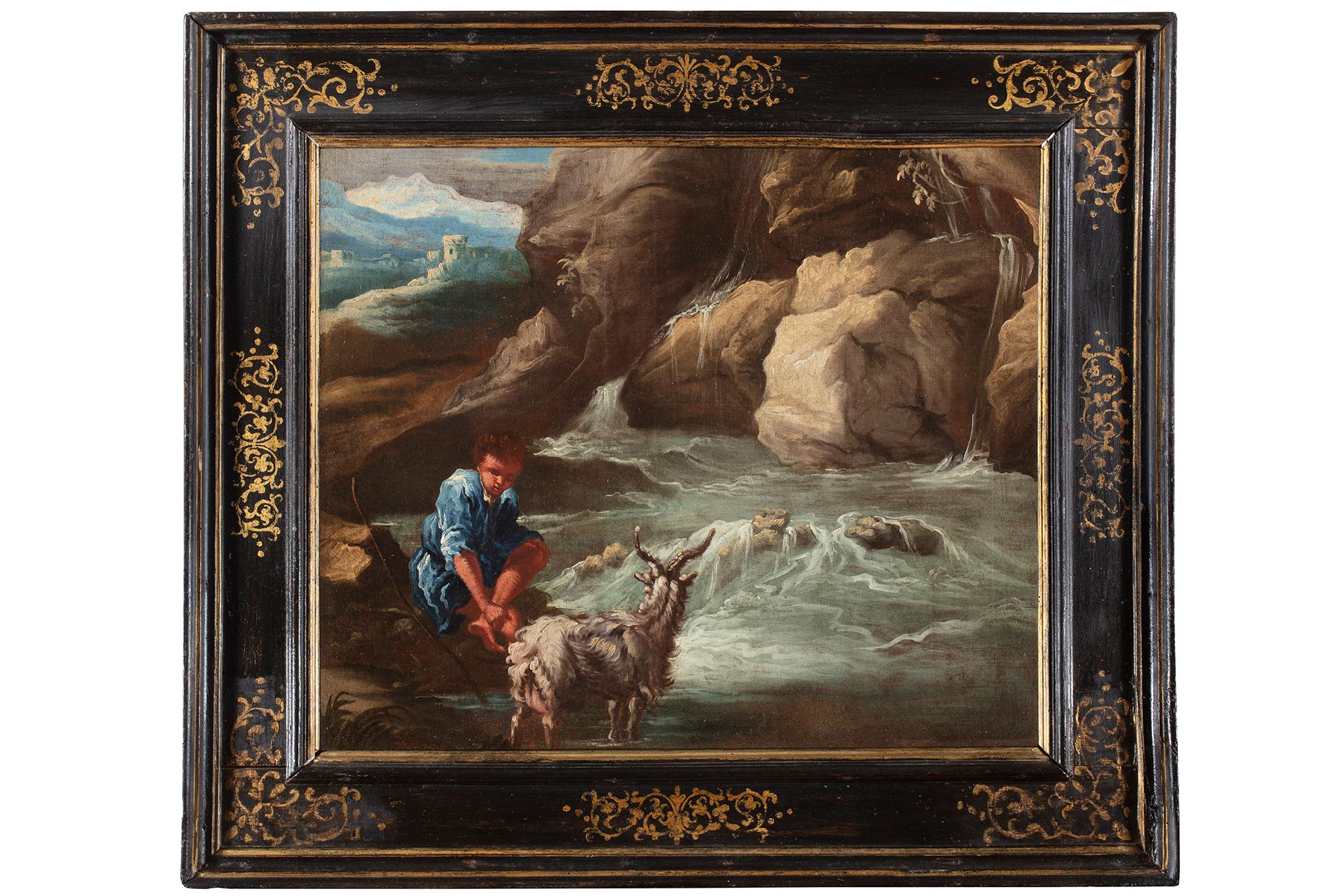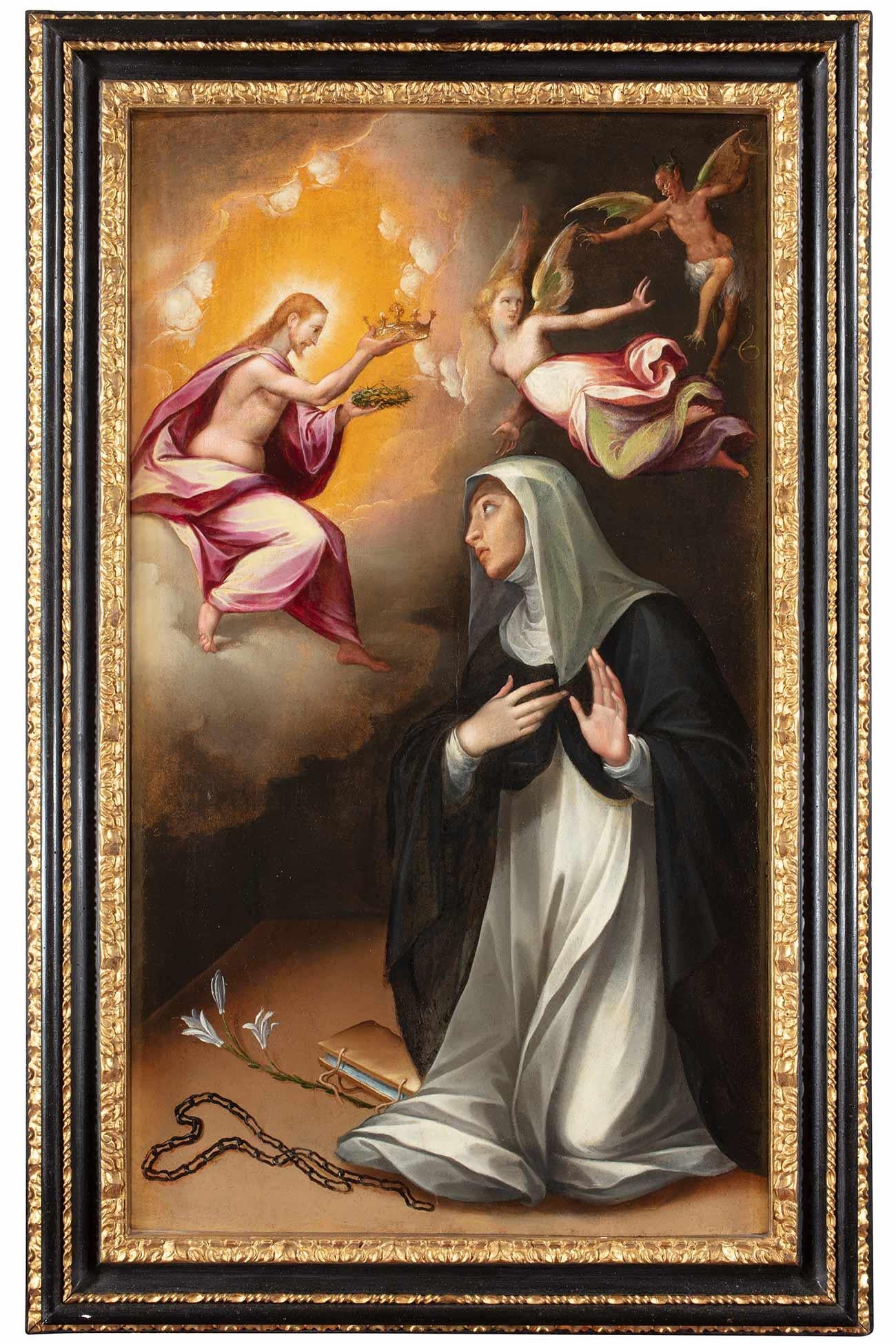Items Similar to 18th Century seascape oil painting of English naval ships & boats off a coast
Want more images or videos?
Request additional images or videos from the seller
1 of 13
Peter Monamy18th Century seascape oil painting of English naval ships & boats off a coastC1720
C1720
About the Item
Peter Monamy
British, (1681-1749)
Oil on canvas
Royal Man-of-War & Naval Ships near a Castle
Image size: 28.5 inches x 38.5 inches
Size including frame: 36.75 inches x 46.75 inches
A Royal man-of-war accompanied by other British Naval ships and rowing boats in choppy seas off the coast, with a fort and landing stage to the far left. The Man-of-War to the foreground bears the royal coat of arms to the bow and flies the red ensign of English naval ships of the time.
Peter Monamy was born in London in 1681 to Pierre Monamy from Guernsey and Dorothy Gilbert. At the age of 15 he was apprenticed to William Clark, Master of the Worshipful Company of Painter-Stainers who provided interior decorations including paintings on panelling, overmantels and murals. Many of his paintings were displayed in the shop window. He succeeded the business upon Clark’s death and began specialising in marine scenes.
He seems to have spent time in Ireland and then Plymouth painting commissions for marine and naval scenes. During the early 1720’s he settled in Westminster taking a studio there and established himself as London's pre-eminent marine painter. Monamy specialised in naval vessels at sea, usually Man-of-War ships off the British coast and often included forts or castles in his paintings.
Examples of his works are held by the Glasgow Museum, Jersey Museum, National Maritime Museum, National Trust, University of Greenwich, Victoria & Albert Museum and The Wilson.
The back of the painting is stamped 'F Leedham Liner'. Francis Leedham was a well-respected 19th century picture liner and cleaner. He worked out of 83 Berwick Street, Soho, London from 1831-1837, 3 Little Edward Street, Wardour Street from 1838-1840 and 3 Duck Lane, Edward Street from 1839-1857. He was the leading picture liner of his day and his impressed stamp can be found on the stretchers of paintings that he relined. Leedham was used by many well-known collectors such as Lord Northwick.
The painting is housed in a new, English made gilt frame, which is in excellent condition.
- Creator:Peter Monamy (1681 - 1749, British)
- Creation Year:C1720
- Dimensions:Height: 36.75 in (93.35 cm)Width: 46.75 in (118.75 cm)Depth: 3.5 in (8.89 cm)
- Medium:
- Movement & Style:
- Period:
- Condition:
- Gallery Location:Moreton-In-Marsh, GB
- Reference Number:1stDibs: LU15626186692
About the Seller
4.9
Platinum Seller
These expertly vetted sellers are 1stDibs' most experienced sellers and are rated highest by our customers.
Established in 1972
1stDibs seller since 2015
271 sales on 1stDibs
Typical response time: <1 hour
Associations
The British Antique Dealers' AssociationLAPADA - The Association of Arts & Antiques DealersInternational Confederation of Art and Antique Dealers' Associations
More From This SellerView All
- 18th Century sporting horse portrait oil painting of a race horse and groomBy Francis SartoriusLocated in Moreton-In-Marsh, GloucestershireFrancis Sartorius British, (1734-1804) Bay Hunter & Groom Oil on canvas, signed Image size: 24.25 inches x 29.25 inches Size including frame: 32 inches x 37 inches A wonderful spor...Category
18th Century Old Masters Animal Paintings
MaterialsOil, Canvas
- 19th Century seascape oil painting of fishing boats off the Dutch coastBy Abraham Hulk the ElderLocated in Moreton-In-Marsh, GloucestershireAbraham Hulk Snr British, (1813-1897) Fishing Boats off the Dutch Coast Oil on canvas, signed Image size: 11.75 inches x 17.75 inches Size including frame: 21.25 inches x 27.25 inch...Category
19th Century Victorian Landscape Paintings
MaterialsCanvas, Oil
- Sporting oil painting of horses & hounds huntingBy George WrightLocated in Moreton-In-Marsh, GloucestershireGeorge Wright British, (1860-1942) On the Scent Oil on canvas, signed Image size: 9.5 inches x 15.5 inches Size including frame: 13 inches x 19 inches George Wright was a sporting and landscape artist who was born in Leeds in 1860. He was the son of George E Wright a cashier and his wife Elizabeth. His brother Gilbert Scott Wright...Category
Late 19th Century Victorian Animal Paintings
MaterialsCanvas, Oil
- 19th Century landscape oil painting of hay makingBy John Clayton AdamsLocated in Moreton-In-Marsh, GloucestershireJohn Clayton Adams British, (1840-1906) Hay Making Oil on canvas, signed & indistinctly dated 187(5)? Image size: 19.5 inches x 31.5 inches Size including frame: 28.5 inches x 40.5 ...Category
19th Century Victorian Landscape Paintings
MaterialsCanvas, Oil
- 19th Century landscape oil painting of a busy villageBy Georgina LaraLocated in Moreton-In-Marsh, GloucestershireGeorgina Lara British, (fl. 1862-1871) Bustling Village Life Oil on canvas, signed Image size: 19.5 inches x 29.5 inches Size including frame: 25.5 inches x 35.5 inches Georgina Lara also known as Edwina Lara was a London painter of rustic farmyard and village scenes. Her work also closely resembles that of Edward Masters...Category
19th Century Victorian Landscape Paintings
MaterialsCanvas, Oil
- 19th century landscape oil painting of a village tavernBy John Holland SeniorLocated in Moreton-In-Marsh, GloucestershireJohn Holland Snr British, (1830-1886) The Malt Shovel Tavern Oil on canvas, signed Image size: 13 inches x 20.5 inches Size including frame: 18.25 inches x 25.75 inches Provenance: Frost & Reed A wonderful painting of figures sat outside a village inn by John Holland Senior. A wagon is shown delivering supplies as another cart drives off towards a windmill in the distance. In the foreground two people cut a log in half whilst their family looks on. The Malt Shovel Inn was most likely the one at Upper Lambourn in Berkshire. Over 500 years old, it was located on Malt Shovel Lane, and was originally a bakery, becoming an inn sometime during the mid 1700’s. It remained as a pub until its closure in 2016. The windmill in the distance was situated outside Lambourn on the road to Baydon. It was built in 1771 but was demolished around 1887 and is now the site of a farm. John Holland Senior was a painter of landscapes and coastal scenes who was born in Nottingham around 1830. He was the son of a painter and brother to Samuel Holland also a painter and sign writer. He was also uncle to his namesake John Holland (1857-1920) whom he taught to work in charcoal and Samuel S. Holland, both of whom were artists. By 1861, he had become a full time artist exhibiting at Suffolk Street from around this time until 1879, at the British Institution between 1865-1866 as well as exhibiting locally in Nottingham. He never married and lived for many years with his father, brother and his family at Vernon Street, Nottingham. Around 1867, he moved to Hebden Bridge in West Yorkshire where he exhibited locally. He would also often travel around the British countryside and coast to paint. He spent a few years in West Yorkshire but by 1871 had moved back to live with his family in Nottingham. However, he spent his final years living at Trebray Lodge, Tintagel, Cornwall where he died on 7 February 1886. A number of his works are held by the Buxton Museum, Calderdale Metropolitan Borough Council, Nottingham Art Gallery and the Williamson Art Gallery. Presentation: The painting is housed in a new, English made gilt frame which is in excellent condition. The reverse bears an old label for Frost & Reed. Frost & Reed are a well-known fine Art Gallery, frame maker and fine art publisher founded in Bristol in 1808 by William Hill. The business was bought by John Frost in 1859 who ran it until his death in 1875. His nephew Walter Frost took over the business and in 1881 brought in William Reed...Category
19th Century Victorian Landscape Paintings
MaterialsCanvas, Oil
You May Also Like
- Early oil depicting the Great Fire of LondonLocated in London, GBThe Great Fire of London in September 1666 was one of the greatest disasters in the city’s history. The City, with its wooden houses crowded together in narrow streets, was a natural fire risk, and predictions that London would burn down became a shocking reality. The fire began in a bakery in Pudding Lane, an area near the Thames teeming with warehouses and shops full of flammable materials, such as timber, oil, coal, pitch and turpentine. Inevitably the fire spread rapidly from this area into the City. Our painting depicts the impact of the fire on those who were caught in it and creates a very dramatic impression of what the fire was like. Closer inspection reveals a scene of chaos and panic with people running out of the gates. It shows Cripplegate in the north of the City, with St Giles without Cripplegate to its left, in flames (on the site of the present day Barbican). The painting probably represents the fire on the night of Tuesday 4 September, when four-fifths of the City was burning at once, including St Paul's Cathedral. Old St Paul’s can be seen to the right of the canvas, the medieval church with its thick stone walls, was considered a place of safety, but the building was covered in wooden scaffolding as it was in the midst of being restored by the then little known architect, Christopher Wren and caught fire. Our painting seems to depict a specific moment on the Tuesday night when the lead on St Paul’s caught fire and, as the diarist John Evelyn described: ‘the stones of Paul’s flew like grenades, the melting lead running down the streets in a stream and the very pavements glowing with the firey redness, so as no horse, nor man, was able to tread on them.’ Although the loss of life was minimal, some accounts record only sixteen perished, the magnitude of the property loss was shocking – some four hundred and thirty acres, about eighty per cent of the City proper was destroyed, including over thirteen thousand houses, eighty-nine churches, and fifty-two Guild Halls. Thousands were homeless and financially ruined. The Great Fire, and the subsequent fire of 1676, which destroyed over six hundred houses south of the Thames, changed the appearance of London forever. The one constructive outcome of the Great Fire was that the plague, which had devastated the population of London since 1665, diminished greatly, due to the mass death of the plague-carrying rats in the blaze. The fire was widely reported in eyewitness accounts, newspapers, letters and diaries. Samuel Pepys recorded climbing the steeple of Barking Church from which he viewed the destroyed City: ‘the saddest sight of desolation that I ever saw.’ There was an official enquiry into the causes of the fire, petitions to the King and Lord Mayor to rebuild, new legislation and building Acts. Naturally, the fire became a dramatic and extremely popular subject for painters and engravers. A group of works relatively closely related to the present picture have been traditionally ascribed to Jan Griffier...Category
17th Century Old Masters Landscape Paintings
MaterialsOil, Canvas
- 18th Century By Vincenzo Re The Pool of Bethesda Oil on CanvasLocated in Milano, LombardiaExpertise by Prof. Giancarlo Sestieri. Vincenzo Re (Parma, 1695 – Napoli?, 1762) born in Parma, was an Italian scenic designer who during his career worked as initially an assistant...Category
18th Century Old Masters Landscape Paintings
MaterialsCanvas, Oil
- 17th Century by Simone Cantarini Adoration of The Magi Painting Oil on CanvasLocated in Milano, LombardiaSimone Cantarini (Pesaro 1612 - Verona 1648) Adoration of the Magi Oil on paper applied to canvas, cm. 16,5 x 24 – with frame cm. 22 x 29 Antique sh...Category
Early 17th Century Old Masters Figurative Paintings
MaterialsCanvas, Cotton Canvas, Oil
- 18th Century by Antonio Stom Architectural Capriccio Oil on Canvas_By Antonio StomLocated in Milano, LombardiaAntonio Stom (Venice c. 1688 - 1734) Architectural Capriccio oil on canvas, cm. 88 x 113 - with frame cm. 106 x 132 Carved, sculpted and gilded wooden frame Expertise: Giancarlo S...Category
Early 18th Century Old Masters Landscape Paintings
MaterialsCanvas, Cotton Canvas, Oil
- 18th Century by Giuseppe Pianca Shepherd with Goat and River Oil on CanvasLocated in Milano, LombardiaGiuseppe Antonio Pianca (Agnona di Borgosesia/VC, 1703 - after 1757) oil on canvas, cm. 49 x 57 - with frame cm. 67 x 77 Antique shaped wooden cassetta frame, ebony and gold decora...Category
18th Century Old Masters Landscape Paintings
MaterialsCanvas, Cotton Canvas, Oil
- 16th Century by Cristofano Roncalli Saint Catherine of Siena Oil on CanvasLocated in Milano, LombardiaCristofano Roncalli (Pomarance 1552 - Rome 1626) Saint Catherine of Siena chooses the crown of thorns oil on wood, cm. 101,5x59.5 - with frame cm. 120x76 Shaped, carved and sculpted wooden cassetta frame, partly gilded and partly ebonized wood Expertise: Marco Ciampolini The marvellous scene that opens before our eyes is that of Christ's apparition to Saint Catherine of Siena; she must choose between a golden crown, the symbol of earthly royalty, and a crown of thorns, the symbol of virtuous Christian sacrifice. Catherine does not hesitate to choose the crown of thorns, her life in imitation of...Category
16th Century Old Masters Landscape Paintings
MaterialsCanvas, Cotton Canvas, Oil





